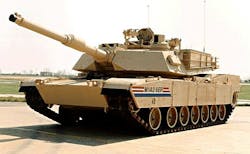General Dynamics gets contract to build 12 advanced main battle tanks with digital vetronics
Editor's note: GE Intelligent Platforms changed its name to Abaco Systems on 23 Nov. 2015 as a result of the company's acquisition last September by New York-based private equity firm Veritas Capital.
WARREN, Mich., 4 Feb. 2014. Armored combat vehicle designers at General Dynamics Land Systems in Sterling Heights, Mich., will build 12 M1A2 Abrams System Enhanced Package (SEP) Version 2 (V2) main battle tanks with digital vetronics under terms of a $72.7 million contract modification announced Friday from the U.S. Army.
The M1A2 SEP V2 is considered to be one of the most technologically advanced and most survivable digital tank available worldwide. The networked tank has an electronic backbone, improved processors, high-resolution color displays, increased memory capacity, a day and night forward-looking infrared (FLIR) sighting system, auxiliary power, a tank-infantry phone, and an open architecture designed to accommodate future upgrades without redesigns.
Officials of the Army Contract Command in Warren, Mich., awarded the contract on behalf of the Army TACOM Lifecycle Management Command (LCMC). General Dynamics will do work on the contract in Lima, Ohio; Scranton, Pa.; Anniston, Ala.; and Tallahassee, Fla., and should be finished by the end of next year.
Related: Army finalizes $395 million contract to General Dynamics to upgrade M1A2 tank vetronics
Building advanced Abrams tanks helps support about 882 industry suppliers, General Dynamics officials say. Among the tank's suppliers is GE Intelligent Platforms in Huntsville, Ala., which provides graphics and communications embedded computing, as well as and rugged commercial off-the-shelf (R-COTS) processors.
The tank's general-purpose processor (GPP) is designed to accept two on-board mezzanine modules in one VME slot, and allows for improved crew operations and vehicle diagnostics. The M1A2 SEP V2 tank, the Army’s premier ground combat system, also has advanced thermal sights and commander’s independent thermal viewer (CITV).
The CITV provides the crew with a hunter-killer capability that enables the M1A2 SEP V2 to acquire targets 45 percent faster and hand off targets 50 to 75 percent faster than the older-model M1A1 tank, which improves its ability to hit evasive targets on the first shot.
Improved digital displays provide tank commanders and crews with a better understanding of their tank’s operational status and their situation on the battlefield. The M1A2 SEP V2 also includes the commander remote operated weapon station (CROWS II), and a thermal management system (TMS).
Digital tanks also enable embedded training on the tank’s computers, and laptop and desktop trainers that simulate the tank’s operating systems.
General Dynamics will do the work as part of an existing contract to upgrade 12 M1A1 Abrams tanks to the M1A2 SEP V2 configuration, company officials say.
Related: Upgrading combat vehicles with versatile vetronics
The original multi-year contract was awarded in February 2008, which authorized the upgrade of 435 M1A1 tanks that have been in the Army’s inventory for more than 20 years.
For more information contact General Dynamics Land Systems online at www.gdls.com, the Army Contracting Command at www.acc.army.mil, or the Army TACOM LCMC at www.tacom.army.mil.

